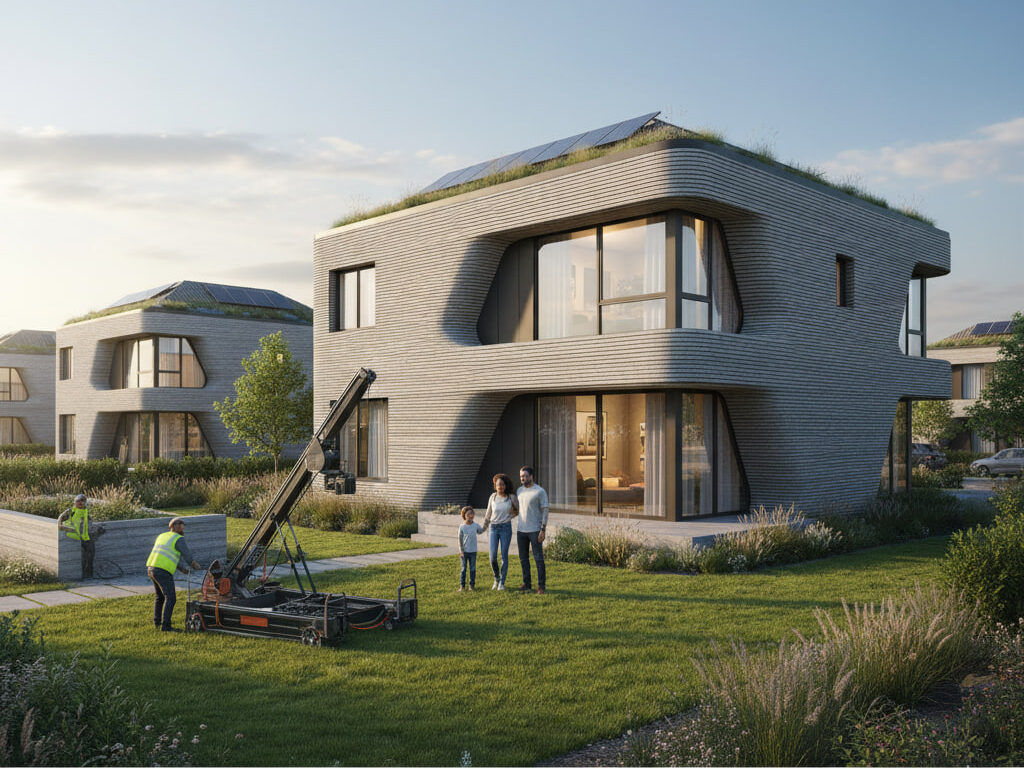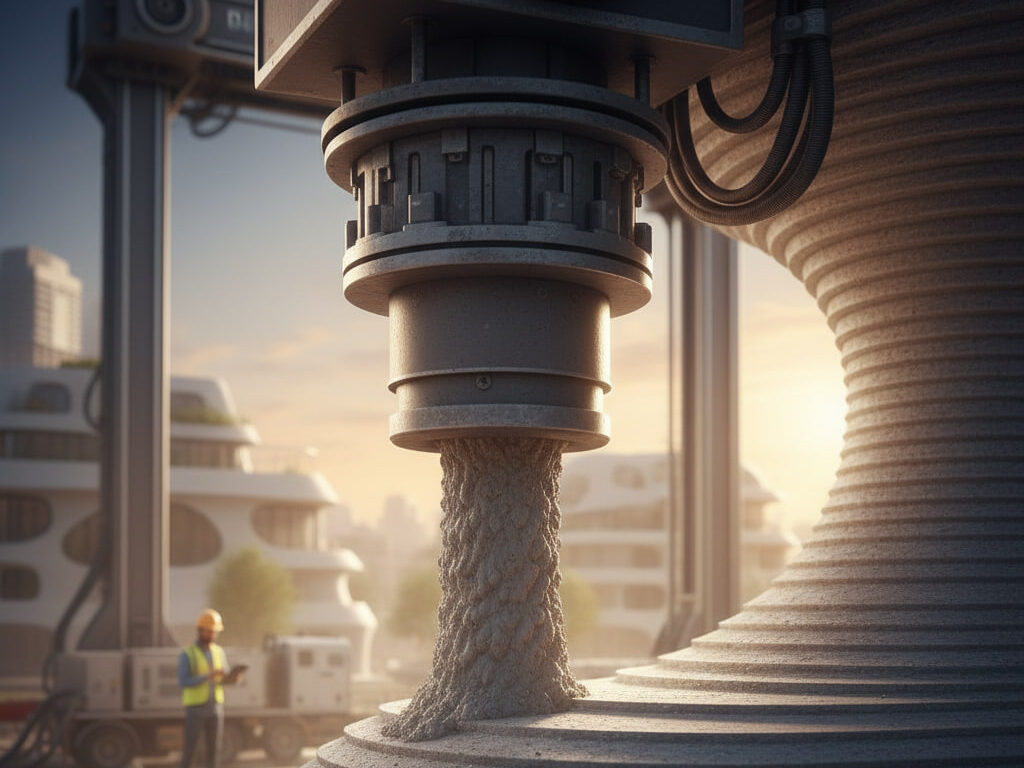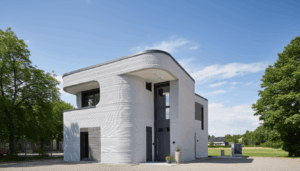For decades, the construction industry has been an outlier. Indeed, while sectors like manufacturing and technology underwent waves of transformation, construction has remained bound by tradition. As a result, it continues to grapple with persistent challenges. These include chronic labor shortages, significant material waste, and high rates of on-site accidents. However, a new technology is now emerging from science fiction into practical reality. This technology promises to challenge every one of these foundational weaknesses.
This technology is additive manufacturing, more commonly known as 3D printing. While many associate it with small desktop models, companies are now deploying a super-sized version on construction sites. Specifically, these systems are not printing toys; they are printing entire buildings. This radical shift from assembling small pieces to printing a whole structure invites a critical question. Are we witnessing a fleeting novelty, or is this the start of a revolution in how we build our world?
This article serves as a comprehensive introduction to this technology. First, we will explore what construction 3D printing truly is. Next, we will analyze the fundamental industry problems it can solve. Finally, we will assess its potential to redefine the architectural and construction landscape.
What is Construction 3D Printing?
At its core, Construction 3D Printing (C3DP) is a process for creating three-dimensional structures. It progressively deposits material layer by layer, following a digital model. In essence, it scales the concept of desktop 3D printing to an architectural magnitude. However, instead of plastic filament, these industrial machines use a specialized building material. This is most commonly a proprietary, fast-setting concrete or mortar mix.
The process begins in the digital realm. First, an architect or designer creates a 3D model using BIM or CAD software. Then, specialized software “slices” this digital blueprint into a series of thin horizontal layers. This file provides the complete instruction set for the printer.
On the construction site, the hardware begins its work. This hardware is typically a massive gantry system or a highly flexible robotic arm. The system mixes the printing material to the perfect consistency. Afterwards, it pumps the material through a hose to a nozzle on the printing head. Following the precise path from the digital file, the nozzle extrudes a single layer of material. It completes one layer, moves up, and then begins the next. Thus, it progressively builds the structural walls from the ground up. The key innovation is the thixotropic material. Specifically, it is fluid enough to pump but stiff enough to support the layers above it almost immediately. As a result, this process entirely eliminates the need for traditional formwork.
The Core Pillars of the 3D Printing Promise
The true potential of 3D printing lies in its ability to solve the industry’s most deeply entrenched problems.
A Quantum Leap in Speed and Efficiency
The most striking advantage of C3DP is its incredible speed. For example, conventional wall construction is a multi-stage, labor-intensive process that can take weeks. In contrast, a 3D printer can extrude the entire wall system for a small home in just 24 to 48 hours. This is a fundamental disruption of the project timeline. By drastically reducing construction time, subsequent trades like roofing and plumbing can start sooner. Consequently, this acceleration reduces project costs and delivers a much faster return on investment.
Redefining Waste and Sustainability
The construction industry is one of the largest producers of waste globally. A significant portion comes from material off-cuts and single-use wooden formwork. Therefore, 3D printing fundamentally inverts this wasteful paradigm. As an “additive” process, it places material only where the digital model specifies. There are no off-cuts and no formwork. This alone can reduce on-site construction waste by up to 90%. Moreover, this has immense environmental benefits and also translates into direct cost savings. Furthermore, researchers are actively developing eco-friendly printing materials, such as geopolymers and mixtures that use recycled content.

Unleashing Architectural Freedom
In traditional construction, complexity equals cost. For example, a curved wall is prohibitively expensive for most projects due to custom formwork. This economic reality has limited mainstream architecture to rectilinear forms. In contrast, 3D printing shatters this limitation. For a robotic arm, printing a graceful curve is just as easy as printing a straight line. This capability liberates architects from the “tyranny of the straight line.” It allows for more organic and dynamic forms without a cost penalty. Ultimately, it opens the door to a new architectural vernacular where buildings are more expressive and responsive to their environment.
Enhancing On-Site Safety
Construction sites are inherently dangerous places. Consequently, automating the most hazardous parts of the process can dramatically improve worker safety. 3D printing, for instance, replaces the manual labor of lifting heavy blocks and building precarious formwork. Instead, a small team of technicians oversees a machine from a safe distance. This greatly reduces human exposure to risks like falls and crush injuries. Therefore, it promises a future where construction is a safer profession for everyone.
The Broadening Scope of 3D Printing
While single-family homes capture the public imagination, the technology’s applications extend far beyond them. Indeed, its versatility is already appearing in a range of innovative projects:
- Infrastructure and Urbanism: For example, teams in the Netherlands and China have successfully deployed 3D-printed bridges, showcasing the technology’s ability to handle genuine structural loads.
- Architectural Components: In addition, companies are using the technology to print complex elements like ornate facade panels or permanent formwork.
- Environmental Solutions: Scientists are also creating 3D-printed artificial reefs. These reefs have complex textures designed to help restore marine ecosystems.
- Humanitarian and Off-World Applications: The speed of 3D printing makes it ideal for disaster relief. Looking further ahead, agencies like NASA are investing in this technology to build habitats on the Moon and Mars.

So, Is It a Revolution in the Making?
With its potential to build faster, cheaper, and safer, 3D printing has the hallmarks of a disruptive technology. In fact, it is a paradigm shift that moves construction closer to the efficiency of modern manufacturing.
However, the revolution is not yet complete. The technology is still in its early stages of adoption. Significant hurdles remain in areas like building codes, material sciences, and reinforcement techniques. Moreover, the industry needs to train a new workforce. While these are significant challenges, they are the kind of obstacles that every groundbreaking technology has overcome.
Therefore, the question is no longer if 3D printing will find a place in construction. The question now is how large and transformative that place will be.
Conclusion
Construction 3D printing is far more than a futuristic curiosity. Instead, it is a practical solution to the challenges that have held the industry back for a century. It offers a compelling vision of a future where construction is faster, more sustainable, and safer. As a result, the time to simply observe this technology is closing. For anyone who intends to build the world of tomorrow, understanding its principles and potential is becoming essential. The digital blueprint has been loaded, and the first layers of a new era are being printed before our eyes.







